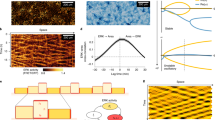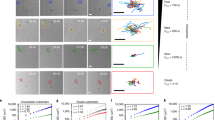Abstract
Collective cell migration is fundamental throughout development, during wound healing and in many diseases. Although much effort has focused on cell–cell junctions, a role for physical confinement in collective cell migration remains unclear. Here, we used adhesive microstripes of varying widths to mimic the spatial confinement experienced by follower cells within epithelial tissues. Our results reveal that the substrate area confinement is sufficient to modulate the three-dimensional cellular morphology without the need for intercellular adhesive cues. Our findings show a direct correlation between the migration velocity of confined cells and their cell–substrate adhesive area. Closer examination revealed that adhesive area confinement reduces lamellipodial protrusive forces, decreases the number of focal complexes at the leading edge and prevents the maturation of focal adhesions at the trailing edge, together leading to less effective forward propelling forces. The release of follower confinement required for the emergence of leader cells is associated with a threefold increase in contractile stress and a tenfold increase in protrusive forces, together providing a sufficient stress to generate highly motile mesenchymal cells. These findings demonstrate that epithelial confinement alone can induce follower-like behaviours and identify substrate adhesive area confinement as a key determinant of cell velocity in collective migration.
This is a preview of subscription content, access via your institution
Access options
Access Nature and 54 other Nature Portfolio journals
Get Nature+, our best-value online-access subscription
$29.99 / 30 days
cancel any time
Subscribe to this journal
Receive 12 print issues and online access
$209.00 per year
only $17.42 per issue
Buy this article
- Purchase on Springer Link
- Instant access to full article PDF
Prices may be subject to local taxes which are calculated during checkout






Similar content being viewed by others
Data availability
The data that support the plots within this paper and other findings of this study are available from the corresponding author upon request.
References
Keller, R. Shaping the vertebrate body plan by polarized embryonic cell movements. Science 298, 1950–1954 (2002).
Farooqui, R. & Fenteany, G. Multiple rows of cells behind an epithelial wound edge extend cryptic lamellipodia to collectively drive cell-sheet movement. J. Cell Sci. 118, 51–63 (2004).
Friedl, P. & Gilmour, D. Collective cell migration in morphogenesis, regeneration and cancer. Nat. Rev. Mol. Cell Biol. 10, 445–457 (2009).
Ilina, O. & Friedl, P. Mechanisms of collective cell migration at a glance. J. Cell Sci. 122, 3203–3208 (2009).
Ridley, A. J. Cell migration: integrating signals from front to back. Science 302, 1704–1709 (2003).
Murrell, M., Oakes, P. W., Lenz, M. & Gardel, M. L. Forcing cells into shape: the mechanics of actomyosin contractility. Nat. Rev. Mol. Cell Biol. 16, 486–498 (2015).
Mayor, R. & Etienne-Manneville, S. The front and rear of collective cell migration. Nat. Rev. Mol. Cell Biol. 17, 97–109 (2016).
Friedl, P. & Alexander, S. Cancer invasion and the microenvironment: plasticity and reciprocity. Cell 147, 992–1009 (2011).
Wong, I. Y. et al. Collective and individual migration following the epithelial–mesenchymal transition. Nat. Mater. 13, 1063–1071 (2014).
Vedula, S. R. K. et al. Emerging modes of collective cell migration induced by geometrical constraints. Proc. Natl Acad. Sci. USA 109, 12974–12979 (2012).
Abercrombie, M. & Heaysman, J. E. Observations on the social behaviour of cells in tissue culture. I. Speed of movement of chick heart fibroblasts in relation to their mutual contacts. Exp. Cell Res. 5, 111–131 (1953).
Stoker, M. G. P. & Rubin, H. Density dependent inhibition of cell growth in culture. Nature 215, 171–172 (1967).
Angelini, T. E. et al. Glass-like dynamics of collective cell migration. Proc. Natl Acad. Sci. USA 108, 4714–4719 (2011).
Garcia, S. et al. Physics of active jamming during collective cellular motion in a monolayer. Proc. Natl Acad. Sci. USA 112, 15314–15319 (2015).
Keren, K. et al. Mechanism of shape determination in motile cells. Nature 453, 475–480 (2008).
Lacayo, C. I. et al. Emergence of large-scale cell morphology and movement from local actin filament growth dynamics. PLoS Biol. 5, e233 (2007).
Fournier, M. F., Sauser, R., Ambrosi, D., Meister, J.-J. & Verkhovsky, A. B. Force transmission in migrating cells. J. Cell Biol. 188, 287–297 (2010).
Riaz, M., Versaevel, M., Mohammed, D., Glinel, K. & Gabriele, S. Persistence of fan-shaped keratocytes is a matrix-rigidity-dependent mechanism that requires α5β1 integrin engagement. Sci. Rep. 6, 34141 (2016).
Verkhovsky, A. B. Orientational order of the lamellipodial actin network as demonstrated in living motile cells. Mol. Biol. Cell 14, 4667–4675 (2003).
Ofer, N., Mogilner, A. & Keren, K. Actin disassembly clock determines shape and speed of lamellipodial fragments. Proc. Natl Acad. Sci. USA 108, 20394–20399 (2011).
Prass, M., Jacobson, K., Mogilner, A. & Radmacher, M. Direct measurement of the lamellipodial protrusive force in a migrating cell. J. Cell Biol. 174, 767–772 (2006).
Mogilner, A. & Oster, G. Cell motility driven by actin polymerization. Biophys. J. 71, 3030–3045 (1996).
Borm, B., Requardt, R. P., Herzog, V. & Kirfel, G. Membrane ruffles in cell migration: indicators of inefficient lamellipodia adhesion and compartments of actin filament reorganization. Exp. Cell Res. 302, 83–95 (2005).
Rolli, C. G. et al. Switchable adhesive substrates: revealing geometry dependence in collective cell behavior. Biomaterials 33, 2409–2418 (2012).
Trepat, X., Chen, Z. & Jacobson, K. Cell migration. Compr. Physiol. 2, 2369–2392 (2012).
Lantoine, J. et al. Matrix stiffness modulates formation and activity of neuronal networks of controlled architectures. Biomaterials 89, 14–24 (2016).
Versaevel, M., Riaz, M., Grevesse, T. & Gabriele, S. Cell confinement: putting the squeeze on the nucleus. Soft Matter 9, 6665–6676 (2013).
Versaevel, M., Grevesse, T., Riaz, M., Lantoine, J. & Gabriele, S. Micropatterning hydroxy-PAAm hydrogels and Sylgard 184 silicone elastomers with tunable elastic moduli. Methods Cell Biol. 121, 33–48 (2014).
Coppée, S., Gabriele, S., Jonas, A. M., Jestin, J. & Damman, P. Influence of chain interdiffusion between immiscible polymers on dewetting dynamics. Soft Matter 21, 9951–9955 (2011).
Grevesse, T., Versaevel, M., Circelli, G., Desprez, S. & Gabriele, S. A simple route to functionalize polyacrylamide hydrogels for the independent tuning of mechanotransduction cues. Lab Chip 13, 777–1 (2013).
Grevesse, T., Versaevel, M. & Gabriele, S. Preparation of hydroxy-PAAm hydrogels for decoupling the effects of mechanotransduction cues. J. Vis. Exp. 90, 1–8 (2014).
Versaevel, M., Grevesse, T. & Gabriele, S. Spatial coordination between cell and nuclear shape within micropatterned endothelial cells. Nat. Comm. 3, 671 (2012).
Butt, H. J. & Jaschke, M. Calculation of thermal noise in atomic force microscopy. Nanotechnology 6, 1–7 (1995).
Peng, T. et al. BaSiC tool for background and shading correction of optical microscopy images. Nat. Commun. 8, 14836 (2017).
Acknowledgements
The authors gratefully acknowledge C.-P. Heisenberg for kindly providing the GFP–UTR zebrafish line, A. Kennard for technical advice for culture of zebrafish embryos and M. Surin for technical support with AFM measurements. The authors thank M. Balland, B. L. Pruitt, M. Sixt, D. Fletcher, J. Theriot and J. Ding for insightful discussions. This work was conducted with the financial support from the Belgian National Fund for Scientific Research (F.R.S.-FNRS, Crédit de Recherches - J009916F) and FEDER Prostem. D.M., J.L., L.A., C.B., E.V. and M.L. are financially supported by FRIA (F.R.S.-FNRS). G.C. is supported by an ERC CoG grant (MolCellTissMech, agreement 647186). K.G. is a Research Associate of the F.R.S.-FNRS.
Author information
Authors and Affiliations
Contributions
D.M. and S.G. conceived the project. G.C. and S.G. supervised the project. D.M. and E.V. performed the experiments. C.B. helped with traction force experiments and data analysis. G.D. and O.T. performed PRIMO experiments to create new adhesive micropatterns. K.G. contributed to the silicon wafer microfabrication. M.V., J.L., L.A., C.B. and M.L. contributed resources to the project. D.M., G.C. and S.G. analysed data, wrote the main manuscript text and prepared the figures. All authors contributed to the interpretation of the results, and improved the manuscript and figure presentations.
Corresponding author
Ethics declarations
Competing interests
The authors declare no competing interests.
Additional information
Journal peer review information: Nature Physics thanks Kinneret Keren and the other, anonymous, reviewer(s) for their contribution to the peer review of this work.
Publisher’s note: Springer Nature remains neutral with regard to jurisdictional claims in published maps and institutional affiliations.
Supplementary information
Supplementary Information
Supplementary Figs. 1–9.
Supplementary Video 1
Time-lapse sequence in DIC mode of the growth of an epithelial tissue from a fish scale deposited on a glass coverslip coated with FN. Total duration: 304 min. The scale bar is 100 μm.
Supplementary Video 2
Time-lapse sequence in DIC mode of the migration of a single keratocyte migrating on a 15-μm-wide microstripe. The FN micropattern is shown in fluorescence mode at t = 5 min. Total duration: 9 min 11 s. The scale bar is 10 μm.
Supplementary Video 3
Time-lapse sequence in DIC mode of the migration of a single keratocyte migrating on a FN micropattern composed of 5 interconnected stripes of different widths: 5, 9, 13, 17 and 21 µm. The total length of the micropattern with variable widths is 320 µm. The total time is 109 min and the scale bar is 10 µm.
Supplementary Video 4
Time-lapse sequence in DIC mode of the cantilever assay to measure protrusive forces. A single keratocyte migrating on a 15-μm-wide microstripe pushed the cantilever. One can observe the cantilever deflection in response to the pushing force exerted by the leading edge of the oncoming cell.
Supplementary Video 5
Time-lapse sequence in DIC mode showing a leader cell that escaped from an epithelial tissue. The red arrow at t = 0 min shows the initial position of the leader cell. The total duration time is 25 min. The scale bar is 25 μm.
Supplementary Video 6
Time-lapse sequence in DIC mode showing a single keratocyte that escaped from a narrow microstripe. The escape process was reproduced by using micropatterns composed of adhesive lines 12 μm wide connected to a circular disc of 50 μm in diameter. The total duration time is 5 min 50 s. The scale bar is 10 μm.
Supplementary Video 7
Time-lapse sequence in SiR-actin mode showing a single keratocyte that escaped from a narrow microstripe. The escape process was reproduced by using micropatterns composed of adhesive lines 12 μm wide connected to a circular disc of 50 μm in diameter. The total duration time is 4 min 25 s. The fluorescence intensity is colour-coded on 256 levels. The scale bar is 15 μm.
Supplementary Video 8
Time-lapse sequence in epifluorescent mode of a GFP–UTR zebrafish keratocyte (in green) migrating on a FN-coated microstripe 15 µm wide connected to a circular disc of 50 µm in diameter. The FN micropattern is labelled in red.
Supplementary Video 9
Time-lapse sequence in DIC mode of the migration of a train of cells (n = 2 cells) on a FN-coated microstripe 15 µm wide.
Rights and permissions
About this article
Cite this article
Mohammed, D., Charras, G., Vercruysse, E. et al. Substrate area confinement is a key determinant of cell velocity in collective migration. Nat. Phys. 15, 858–866 (2019). https://doi.org/10.1038/s41567-019-0543-3
Received:
Accepted:
Published:
Issue Date:
DOI: https://doi.org/10.1038/s41567-019-0543-3
This article is cited by
-
How multiscale curvature couples forces to cellular functions
Nature Reviews Physics (2024)
-
Geometric constraint-triggered collagen expression mediates bacterial-host adhesion
Nature Communications (2023)
-
Mechanical waves identify the amputation position during wound healing in the amputated zebrafish tailfin
Nature Physics (2023)
-
Switch of cell migration modes orchestrated by changes of three-dimensional lamellipodium structure and intracellular diffusion
Nature Communications (2023)
-
Mechanics and functional consequences of nuclear deformations
Nature Reviews Molecular Cell Biology (2022)



